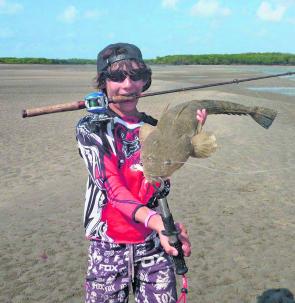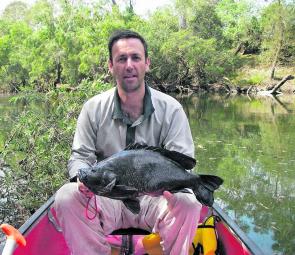May brings a real change of seasons and, hopefully, fishing prospects. We are still getting plenty of rain, but it should decrease this month and see the waterways clear up.
Around Easter things were looking really good with the water starting to clear nicely and, with plenty of bait around, the fish really start to come on the chew. This last lot of rain has seen the creeks running dirty freshwater, which has again made locating fish difficult, but far from impossible.
While species such as grunter, whiting, bream and flathead don’t particularly enjoy the dirty water in the creeks and estuaries, both king and blue salmon are quite commonly found in the discoloured water. Over the last couple of weeks they have been the mainstay of the small boat angler along, with some barra and estuary cod. I expect that both of these top sporting and eating fish will continue to feature in anglers’ bags through May and June.
Salmon are about in good numbers throughout our region and can be found along beaches, and right up to the top of the creeks and estuaries, particularly in Rocky Dam creek, Reliance, Constant and Murray creeks. While they will take lures, most catches are made on bait. Salmon will happily scoff down strip baits of mullet and whiting, live small fish, live or fresh prawns, and a bunch of yabbies. This wide range of baits gives all anglers a good shot at bagging a salmon or two.
For the lure angler, I suggest any small to medium size barra hardbody lure but stick to quality brands as salmon can also be pretty tough on hooks and quality trebles, and rings are a must. Plus there is always the chance of running across a decent barra and it is a disaster to hook a good barra and lose it due to poor quality hardware.
The best lures for salmon are the soft plastics in a variety of styles and colours. Possibly the best bet is to use one of the many prawn imitations on the market as small prawns make up a large portion of both species’ diet. The old reliable Prawnster and the newer Zemek range are proven performers, but there are now many others around that will also work well on salmon. These prawn imitations are very useful worked around the shallows, but it is essential to keep noise to a minimum and that means anchoring a good way off, quietly and using long casts to work over an area.
Paddle and curly tails also work well on salmon, with the smaller ones a favourite. Sizes up to about 75mm seem to be more to their liking than the larger models and, fortunately, this size is also attractive to many other species, like cod, jacks, barra, queenies and trevally, all of which can be found in our creek systems. I prefer to stick with more natural colours for all my plastics, and clear or slightly tinted ones work well. The exception to this is pure white, which is a very successful colour.
Salmon like mud banks. They seem to enjoy poking around on shallow sloping banks or at high tide right up on top of mud banks that are otherwise exposed lower in the tide cycle. Almost every estuary/creek system in our area has this type of habitat, which explains the wide spread of salmon throughout the district.
Many anglers use wire trace for salmon, as they have fine sandpaper like teeth, but I prefer to use heavy nylon or fluorocarbon leader material. It can handle the salmon but should be regularly checked and changed as necessary. As an all round leader, I use 15 or 20kg fluorocarbon and suffer very few bite or bust offs. Make sure your knots are up to scratch as when a big king hits the afterburners and takes off you want to have full confidence in your rig.
I expect coming into May that the rains will be mostly finished and the water should be clearing up nicely. It will coincide with the movement of big whiting into our creeks and also mean that flathead, bream and grunter will also show up more in anglers’ catches. These species again can be found throughout the estuaries/creeks and will respond to many baits and lures; the best bait being freshly pumped yabbies.
Best places to look for these bread and butter species through May will be the Pioneer River, Sarina Inlet, and any of the previously mentioned creeks. For the shore-based angler, try Bakers Creek, Eimeo Creek, McEwans Beach and around the Dunrock areas where there is plenty of shore-based access and also plenty of yabbies.
May is also a good time for the close offshore angler as it is usually the month when big queenfish and golden trevally start to show up regularly.
If the winds ever die down and the bait schools come in, towards the end of the month there may be the first run of school macks. Spanish mackerel normally start to show up more towards the end of May.
Bait schools and light winds are the keys to getting among these species for the small boat angler, or even those who fish from the harbour break walls. Many an idle moment will be spent going for a cruise to the harbour to see what’s going on, and once the bait starts to show up word gets around pretty quickly.
Around the end of the month will also likely see the arrival of snapper in our waters on their annual breeding run. The local tackle store staff will know when they show up, so it’s a good time to buy some new gear, and sus out the latest info on what’s on the chew and where.
The freshwater scene has been fairly quiet of late with the big inflows of dirty cold water, but again May should see the dams and the river start to clear up, and the water temps are still usually mid to high 20. There should be plenty of barra activity, as well as hard pulling sooties.
So from salmon to sooties there is a good variety to be enjoyed during May. See you at the ramp.
Reads: 1442






